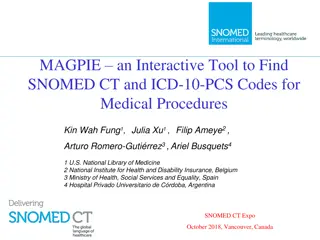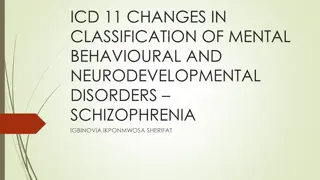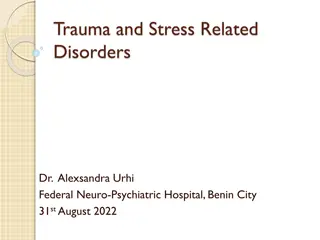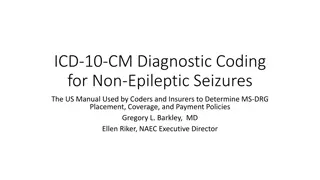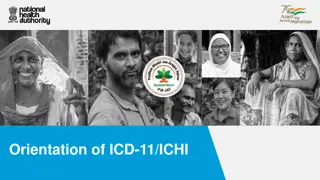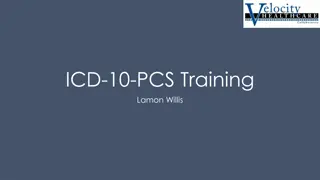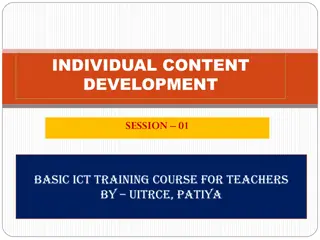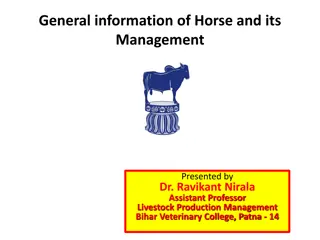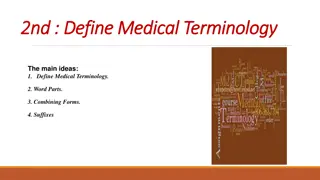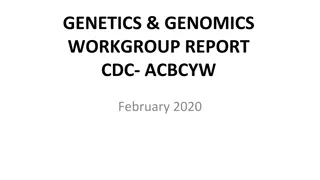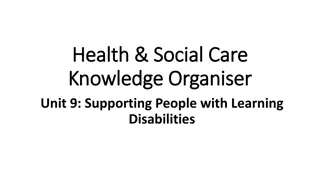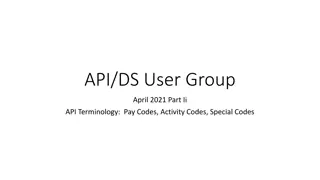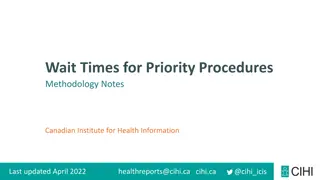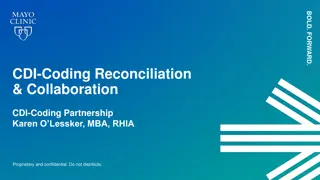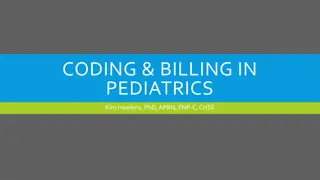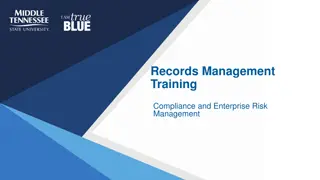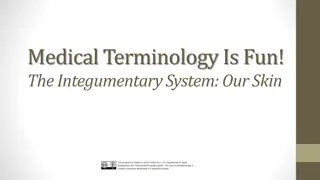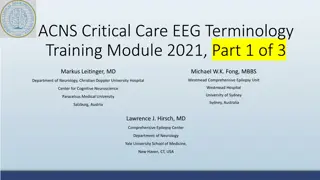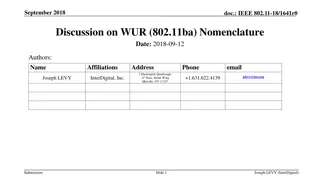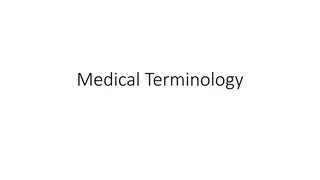Understanding ICD-11 and ICHI: Terminology, Overview, and Purpose
International Classification of Diseases (ICD-11) and International Classification of Health Interventions (ICHI) provide a comprehensive framework for recording and analyzing health data globally. The system ensures semantic interoperability, integrates terminology and classification, and supports various use cases beyond basic health statistics. Designed for multiple applications, including decision support, resource allocation, reimbursement, and guideline development. Explore the terminology, overview, and key uses of ICD-11 and ICHI for effective health data management and analysis.
Download Presentation

Please find below an Image/Link to download the presentation.
The content on the website is provided AS IS for your information and personal use only. It may not be sold, licensed, or shared on other websites without obtaining consent from the author. Download presentation by click this link. If you encounter any issues during the download, it is possible that the publisher has removed the file from their server.
E N D
Presentation Transcript
Overview of ICD-11/ICHI
Terminology ICD International Classification of Diseases International Statistical Classification of Diseases and related health problems ICHI International Classification of Health Interventions Interventions for treatment, prevention and diagnostics: medical, nursing, rehabilitation, laboratory, imaging, ultrasound, public health.
Common Foundation Extension Codes WHO Terminologies ICD WHO INN (non proprietary names - medicaments) WHO Devices ICD-O - Histopathology (tumours) Anatomy Details of external causes Severity Infectious agents - ICHI - - WHO WHO core c classifi lassific ca at tio ion ns s core Related Classifications, Terminologies, Standards - - ICF ICNP Nursing ICPC Family med.Aspects ATC Medicament dosage use Orphanet Rare diseases LOINC/NPU Laboratory - - - - - - - Other systems (OBO, HPO, SNOMED, MedDRA) WHO-FIC
ICD-11 Legally mandated health data standard (WHO Constitution and Nomenclature Regulations) In effect from January 2022 Conceptual framework independent of language and culture Integration of terminology and classification End-to-end digital solution (API, tools, online and offline) Up-to-date scientific knowledge Comparable statistics and semantic interoperability - for 150 years Distributed under Creative Commons Attribution-NoDerivs 3.0 IGO license July 20, 2024
ICD Purpose and Uses As a classification and terminology ICD-11: Allows the systematic recording, analysis, interpretation and comparison of mortality and morbidity data collected in different countries or regions and at different times; Ensures semantic interoperability and reusability of recorded data for the different use cases beyond mere health statistics, including decision support, resource allocation, reimbursement, guidelines and more. July 20, 2024
Designed for Multiple Uses 7/20/2024
Codes and URI Combinations: 14000 stat.categories (codes) ICD-10 Statistical system imposed for clinical use Separatetextindex Separaterulebase Primitive structure with focus on statistics. Missing a lot of clinical detail Print product Need terminologylink 30 yearsoutdated content 8 WO-FIC
ICD-11 CodesandURI Combinations: 17000 stat.categories (codes) Clinical systems for statistical use 80000 entities Ontology with multiple parenting from which statistical information is derived. All desired clinical detail codable, eventually with code combinations More detail beyond statistical categories (foundation in yellow) 120000 terms >1600000 terms with formalized post- coordination Input from clinical modifications of ICD-10 Searchable in Google style without training
Updation in Version-11 New chapters and sections Diseases of the immune system Sleep wake disorders Conditions related to sexual health Optional section Traditional Medicine Conditions Disability assessment Scheme (WHO- DAS) Redesigned Diseases of Skin Improved functioning of External causes In line with major international initiatives, as Patient safety reporting Antimicrobial resistance documentation Detail for DRG (integration of clinical modifications of ICD) Detail for primary care
Updation in Version-11 Codes for COVID-19 Neoplasms New hierarchy Inclusion of histopathology, basalioma, melanoma types Coding for Grade and Stage Nervous system More clinical detail Moved cerebrovascular diseases here Cardiovascular system Myocardial infarction STEMI- non-STEMI updated arrhythmias and pulmonary hypertension
ICD-11 -statistical core (26 chapters) Traditional medicine conditions (optional dual coding) Ancient Chinese roots Need for treatment of illnesses Conditions need specific treatment Need for Health services Conditions Factors influencing Ancient India roots External cause Maternal Neonate General population Functioning assessment (WHO DAS2) Trauma Infection Congenital Tumour Other Eye Ear Sexual Health Immune system Psychiatry Respiratory Skin Urogenital Blood Cardiovascular Digestive Musculoskeletal Endocrine Neuro Signs Symptoms Sleep- Wake
Coding Pattern Extension codes- Terminology Conditions - Classification Severity Temporality Anatomy Laterality Consciousness Diagnoses Injuries Signs Symptoms Infectious agents and AMR Histopathology (ICD-O) Findings Chemicals and Medicaments (INN) Reasons for encounter or health status Devices External causes of illness & death Mechanisms of harm (Safety) Activities Places Objects Traditional medicine conditions Functioning assessment WHO-DAS2
Easy to use multiple tools Guide for implementation of ICD-11* timelines steps questions Mappings ICD-11 self learning training online Field implementation and testing platform Webinars and online class for coding DRG system (under development) API and coding tool that can be embedded LOCALLY or ONLINE
Easy to use Type a diagnostic statement into the Coding Tool e.g. cancer of stomach The Coding Toolwill find the best match
Easy to use Type a diagnostic statement into the Coding Tool e.g. Osteoarthritis of right knee The Coding Tool will find the best match including the code combination (postcoordination) information for left or right (laterality)
ICD-11 Benefits Improved usability o Less training o Easily add all clinical detail Add terms Improved usability o Less training o Easily add all clinical detail Add terms Up-to-date scientific knowledge Better use of health resources o DRG o Patient Safety Improved incorporation in electronic environments Clinical terms Linkage to relevant other classifications and terminologies Online and offline digital paper Creative commons license = free for commercial and non- commercial use
ICHI multiple uses The International Classification of Health Interventions (ICHI) is a common tool for reporting and analysing health interventions for clinical and statistical purposes. ICHI covers interventions carried out by a broad range of providers across the full scope of health systems and includes interventions on: diagnostic, medical, surgical, mental health, primary care, allied health, functioning support, rehabilitation, traditional medicine and public health. The classification is built around three axes: Target (the entity on which the Action is carried out), Action (a deed done by an actor to a target) and Means (the processes and methods by which the Action is carried out). ICHI
ICHI multiple uses Extension codes are shared with ICD and ICF in the common foundation and allow users to describe additional detail about the intervention in addition to the relevant ICHI code. A simple, logical syntax links ICHI stem codes and extension codes, interventions performed together, and packages of interventions. The number of categories in ICHI, is determined with regard to the use cases for ICHI and the need for stability of the classification over time. The terminological core allows for a high level of detail (granularity) for all kinds of clinical documentation and data usage. The Beta-3 version of ICHI was released in October 2020. The component relating to clinical interventions has been finalized. The components on functioning interventions and public health interventions are under final review and are finalized 2021
ICHI multiple uses National use of ICHI Patient safety and quality HealthSystemPerformance FrameworkforWHOinterventions Internationalcomparison SustainableDevelopmentindicators UniversalHealthindicators essentialinterventions


